- Home
- Tim Winton
Land's Edge Page 2
Land's Edge Read online
Page 2
Back at the shack, where the rest of the family were stirring, we tipped the crays out onto the concrete floor to let them crawl around in their backward, sleepy manner. The little kids shrieked with delight.
Some mornings I slept in and walked down alone to the reef to meet my father. It felt very grown-up to walk so far on my own. The bush was strangely quiet, the sea a murmur on the reefs. The saltbush was pungent and the light was orange. Rabbits, and once a fox, crossed my path. One morning, when my father had taken the Holden instead of walking, he came hammering up the track flat-out to keep from sinking in the powdery sand and fishtailed around a bend to find me standing in the middle of the track. He swerved, I dived, and we had a few solemn minutes of digging and shunting to get the FC out of the scrub. I trembled all the way to breakfast.
Summer days were long at Greenough. We swam in the river and surfed on the beach when the rips weren’t too treacherous. We rowed around the estuary and fished for bream and stood out on the jagged limestone point and baitcast for tailor. Every day my little brother went down to the caravan that served as a shop to try to buy lollies with bits of glass and bottle tops. He had more success some days than others, but at the end of the holidays Mum had to go down and settle his account.
There were horses in a paddock behind the dunes and some mornings my brother and I walked over to watch them. He had a strange fascination with them, a compulsion really. When he was eight or nine he got sick of watching and took to slipping through the fence and mounting them bareback. I watched in a sweat, terrified that he’d be found out and I’d be the one to have my bum kicked, but he only thought of the moment as he road around with his hands in the scruffy mane like the natural he was.
He was the same in the river. At the edge of the sandbar, where the bank fell away to deep water the colour of tea, he strode out repeatedly, convinced he could swim. My mother dragged him out by the hair and went on with the lesson. That’s where we learnt to swim, there in the river, within tantalizing sight of the sea that crashed on the other side of the bar. Swimming is a great mystery, like riding a bike, like reading. Suddenly, after days and weeks of trying and failing, one morning you can do it.
Some mornings when the tide was right out we went onto the reef with screwdrivers to prise off abalone, which we called muttonfish. Dad shucked them and bashed them with a mallet under the tankstand and fried them in butter. We ate tailor, whiting, bream, crayfish and they made up for the frozen bread and milk, the cans of camp pie and baked beans, the dreaded tinned beetroot.
In the afternoons while the seawind brawled in across the rivermouth we lay on our bunks and read. Our noses were peeling, our feet scabby, our hair bleached, our lips chapped. The afternoons were quiet, exhausted, contemplative. Dad read Zane Grey and I remember Mum reading Errol Flynn’s My Wicked, Wicked Ways. The house was full of the smells of fried fish, vinegar and Coppertone. One year I lay there for three weeks, in the midst of broken Christmas presents and Scrabble tiles, and read Jules Verne’s Journey to the Centre of the Earth. It smelt of the library, another world. The print was so small it made me giddy.
When I went to browse in that library someone would have to throw a beach towel over the stuffed eagle in the corner. That bird’s eyes were brown and glassy and they followed me round the room. Its upraised wings and fierce beak were threats I recognised in many a library and classroom later on. A kid can’t always have a towel handy, but those afternoons I was safe and the world of books opened up to me like a dim shaft into the centre of the earth.
Those summers were both active and contemplative, the weather always fair but never gentle. Morning and afternoon I learned the pattern of my life, of hunting and gathering and picking over flotsam in the outdoor world – fishing, diving, swimming, surfing, lighting fires, rowing boats, feeling the landscape rush in from all sides – and of retiring indoors to wonder and write and read where only the breeze could reach me, in there where my dreams were. I would never be content with only one world or the other. At the time it felt like the ideal life, that coastal summer idyll, and maybe I’ve lived all my years a hostage to a six-year-old’s fantasy.
three
Just below me sharks lunge and burrow into a wall of quivering flesh and the sea is pretty with blood. A pall of gulls hangs above the water. A winch grinds into gear. I am fourteen years old and a bus-load of other fourteen-year-olds clamours around me as the sperm whale is winched up slowly onto the flensing deck at Frenchman Bay. As it comes up, a single bronze whaler, unable to leave off gnashing, is dragged onto the deck snout-deep in blubber. It twists its head, hacking and wolfing, until it loses hold and rolls down the slick wood into the water.
The whale is enormous. Its long, stiff lower jaw lies ajar and its eye seems closed. The glossy black flanks are so vast you can barely see where the sharks have been, but already men are upon it, their flensing knives, like glinting hockey sticks, running deep into the blubber so that in only moments the pearly pink flesh begins to show. Held by the cable, the tail extends rigid, but the flukes have dropped.
Men in beanies and sea boots work away with good humour, conscious of the mob above them. The air is putrid with the steam of boiling blubber. It is the most rancid smell I have ever encountered and here and there along the embankment other kids are retching and heaving.
On the upper deck another whale has its head sawn off. Huge mattresses of blubber are hauled past it toward the vats. A steady drizzle floats in from the Sound, subduing the smell somewhat, while sky and sea take on the colour of a single contusion. I am fourteen and this is a school excursion in Albany, Western Australia.
The sea is a field of miracles, a profusion of depths and mysteries. As T.S. Eliot wrote: ‘The sea has many voices, Many gods and many voices.’ It baffles and infuriates humans because we cannot subdue or comprehensively understand it. We haven’t even completely mapped it, let alone explored it.
Australians are surrounded by ocean and ambushed from behind by desert – a war of mystery on two fronts. What worries us about the sea and the desert? Is it scale or simple silence? Historically we see ourselves as outback types, although we know we are suburbanites. Still, we do go to the desert more and more. We buy four wheel drives and swags and designer gear for camping to make our funny little pilgrimages. From the tent door, or across the motel pool of an evening, we watch the earthly stillness of sunset and we wonder. Yet we head back to the coastal cities that poets such as A.D. Hope used to cane us about. Guiltily we spend the rest of our time living on the water or manoeuvring our way ruthlessly toward it. The desert is a spiritual place, we vaguely understand, and the sea the mere playground of our hedonism.
Robert Drewe has long argued that almost every Australian rite of passage occurs on or near the beach. The beach is where we test and prove our physical prowess, where we discover sex; it is often the site of our adulterous assignations, and where we go to face our grown-up failures. In the end, it is where we retire in the sun to await the unknown.
We are not sea people by way of being great mariners, but more a coastal people, content on the edge of things. We live by the sea not simply because it is more pleasant to a lazy nation, but because, of the two mysteries the sea is more forthcoming; its miracles and wonders are occasionally more palpable, however inexplicable they be. There is more bounty, more possibility for us in a vista that moves, rolls, surges, twists, rears up and changes from minute to minute. The innate human feeling from the veranda is that if you look out to sea long enough, something will turn up. We are a race of veranda dwellers and, as Philip Drew writes in his architectural study: ‘The veranda is an interval, a space, where life is improvised. The beach, in Australia, is the landscape equivalent of the veranda, a veranda at the edge of the continent.’
From beneath the furrowed brows of our houses, in the shallows and beyond the surfline, we look out to sea, and things, wonderful things, do turn up.
Nowhere else on the continent is the sense of being trapp
ed between sea and desert so strong as in Western Australia. In many places along this vast and lonely coastline the beach is the only margin between them. From the sea you look directly upon red desert and from the wilderness there is the steely shimmer of the Indian Ocean. There are roos on the beach and shells out on the plain.
Because we have much more landscape and coastline than people, our shores and shallows are still rich in life, diversity and strangeness. We have perhaps more than our fair share of shoreline miracles, of visitations and wonders and, happily, we haven’t destroyed them all yet. In our hunger to control and know everything humans break and spoil. We trash offerings, burn prophets, snub the strange and wonderful. As a schoolboy in Albany I saw this clearly for the first time. A true wonder was dragged up onto a flensing deck and dismantled like a machine in a wrecker’s yard, all so it could be rendered into oil and fertilizer. I saw that day what the ocean could produce and was amazed; I realized what humankind was likely to make of such creations and was dumbfounded.
Western Australians are great trashers and thrashers – it’s a proud tradition and one we’re always threatening to defend by seceding from the rest of the country. A state of small people with big bulldozers. But now and then even we see something that causes us to back off and think before we shoot; little blessings and miracles get through.
Blessings? Miracles? Blame it on a childhood of Sunday Schools if you like. Call them marvels or natural wonders. At the very least they are rare and precious encounters, and some of them are all the more vulnerable, all the more uplifting because they are so public.
Three examples come to mind without a moment’s hesitation, all on the same barren stretch of coast, all rare events and inspiration to even the most jaded veranda-sitter.
From the air, the vast shoals and forked peninsulas of Shark Bay are as confusing, as withholding as abstract art. The western-most tip of Australia defies the eye – whenever you feel a grasp of direction and a sense of perspective coming on, continent becomes island, ocean turns to estuary and you’re left confounded. Shark Bay is 28 000 square kilometres of enclosed water, the country’s biggest estuary.
The land around it looks blotchy and beaten. Desert right to the water, it stains the white beaches vaguely pink. The water is variegated with sandbar whorls, veins of channels, meadows of seagrass like bruises. It’s here that Europeans first met the Great South Land – Hartog, Vlamingh, Dampier – and they didn’t linger because the landscape seemed to shut its eyes and fold its arms against them; it was inscrutable.
At dawn, though, right at sea level, Shark Bay is just another expanse of water. The beach at Monkey Mia bristles with cotton palms. Silhouetted against the sky is the mast of a moored catamaran. Further up, the skeleton of the jetty. Nothing seems to move. When your eyes adjust you see the distinct line where the water meets the shore – the ever-contested margin of high water.
Then comes the silhouettes of people. They’re down there already in shorts, pyjamas and wetsuits, with cameras slung, their murmurs welling. Before the first gulp of tea or bowl of Rice Bubbles in tents or chalets or vans, they are down on the beach, waiting.
By the time you muster the will to join them, the sky is fading from purple to mauve, but the coarse sand is still cold underfoot. At water’s edge, a man in a wetsuit sits down to haul on an enormous single fin in which there are two sockets for his feet. ‘Merde!’ he mutters, having a bit of trouble.
Suddenly the hushed crowd erupts. ‘They’re coming! They’re here!’
From tents and across the rolled-out lawns of new ‘resort’ others come running. Lights are on, doors slam. Someone giggles just this side of hysteria as out on the water a dorsal fin cuts shoreward. The Australian waking nightmare, the dorsal fin. Now another. Then two more.
Pfugh! The sound of a snorkel clearing. Pfugh! Pfugh!
A woman shrieks, ‘The dolphins are here!’ but the crowd shushes her impatiently and a queer religious hush comes upon them. When three bottlenose dolphins surface and dive in unison, running into the brilliant shallows with the day’s first sun glossing their backs, a collective sigh goes up on the beach and the whirr of the videocam begins.
A Japanese man in Tony Llama boots and designer jeans lurches out waist-deep with his great waterpipe of a telephoto lens before him. A dolphin turns its head to cop a look. Hogtied as a hostage, the French man squirms into the water and gets going with his big perspex flipper galumphing on the surface. Two dolphins check him out, make a pass, and head back to the humans. They make a showy sprint by the crowd and peel off separately to return.
In less than a metre of water, three dolphins idle in below thirty outstretched human hands and turn their heads to see. The biggest of them, blotched and scarred, with notches out of its dorsal fin, slips between gasping people, pressing against their thighs. It props on its pectoral fins, arches out of the water, its head turned sideways, and opens its mouth. A half-metre away from you.
You reach out and stroke its side, your arms tangling with those of strangers. The skin is smooth, slick, firm and the body beneath it is heavy. It’s bigger than you. This is a wild dolphin; it is not trained, it has never been in captivity and it has no need to come in here with its companions every day of the year. It clicks and presses against you.
This is the only place in the world you can do this naturally, expect to stand in the water before breakfast, in the middle of the morning, just on sunset, and touch a free dolphin, feel its powerful bulk, look it directly in the eye and feel it slide back out of reach unafraid. This is what all these people have caught planes and buses or spent ten hours in a hot car for. Because none of this is normal, and the ritual has gone on since 1964, before ‘Flipper’, before environmentalism, before the New Age came slinking upon us. Generations of humans and dolphins meeting on the land’s veranda.
Just offshore from Exmouth, against the coral barrier of the Ningaloo Reef, you can cruise slowly southward, rolling in the mild swell and encounter odd swirls on the surface of the water that at first you might mistake for the ‘footprints’ left behind by sounding whales. As you come closer though, you’ll see from the flying bridge that the swirl is more than water. The shadow has a body. It turns and a mighty dorsal fin breaks the surface and you see that it’s a shark. Eight metres of shark. The tail swings by like a factory gate and already you’re fumbling with your goggles and fins, stumbling down to the aft deck and the open transom door, your lungs in the back of your throat.
You crash out into the bottomless blue and see only bubbles and weird-looking jellyfish for a moment. Tiny dustlike bits of plankton ease past, confusing the eye. In fifty-five metres of water you have no sense of scale, nothing to fix onto, so when that small blur appears below you at mid-water you can’t immediately tell if it’s an anchovy or a nuclear submarine. But as it climbs slowly and evens out you see an opening with small fish hung on the underside of it, and quite suddenly you see it’s a shark’s mouth, big as the bucket of a steam-shovel. The shark alters course and the real shock hits you as you begin to see the size of its body. The colossal flanks are delicately spotted, as mesmeric as an Aboriginal dot painting, and at first sight as intimidating as a ship’s hull. Astonishingly silent, unhurried and seemingly in slow motion, but hard work to keep up with for too long. Festooned with remoras, suckers, cleaners, tiny opportunists. Spangled and speckled by the light on the moving surface of the water, it makes you smile around your snorkel.
You take a breath and dive steep into the warm tropic blur to roll onto your back and fin along quietly beneath its pale crowded belly and watch it blot out the sun. Below you, two bronze whalers, tiny with distance, begin to wind their way up toward you as if on submarine updraughts, and you register them, in your slow glide to the surface, as hardly bigger than the bubbles in your trail. They come within ten metres and hold their circle pattern, interested but not excited, and it’s then that you properly understand the size of the creature you’ve been swimming with. You fina
lly get a true sense of scale with these carnivores in sight. This thing is really, unbelievably big. A plankton eater, harmless, majestic, and willing to swim with you a while as longs as you keep your distance and behave yourself. Open-mouthed, it sieves the water and eyes you neutrally. Then slowly, with imperceptible changes to its trim, it tilts away into the deep, tail fin swinging off into the haze below.
You tread water and marvel. Within sight of the shore, you have swum with a whale shark, the ocean’s largest non-mammal. Your snorkel blasts clear and pipes the sound of your hoot.
For months at a time near Exmouth, while the whale sharks feed in the warm, rich water of the Ningaloo, this can be a daily event. The reef itself is spectacle enough, but a swim with a whale shark is a world beater, something that awes even those who do it every day.
Between Shark Bay and the Ningaloo Reef is a lonely, gnarled and cliffy coastline where the sea eats the land and the southerly hacks into every crack and hollow. It’s tough country down there: salt pans, cattle stations, red dirt. Near a giant stockpile of mined salt that looks incongruously like a snow cap in all that shimmering heat is Cape Cuvier.
In June 1993 a dark mass formed at the base of the high yellow cliffs there and spread like the stain of an oil slick two kilometres long. An unseasonal easterly blew the sea flat, and the water was so clear that onlookers could see the black belt change shape, elongating here, fattening up there, as though it were alive. To seaward, on the perimeter, were other shadows, small mobile blots that moved in on the big mass, causing it to retreat and press up against the cliffbase so close the spectator could now make out what he still couldn’t believe. That was no oil slick down there. It was a vast school of fish being herded by tiger sharks, spanish mackerel and Bryde’s whales beneath a natural amphitheatre.

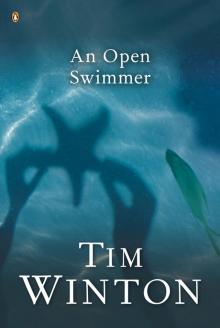 An Open Swimmer
An Open Swimmer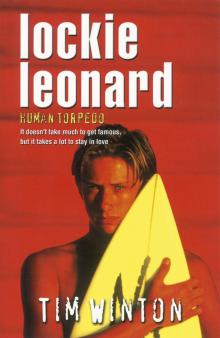 Human Torpedo
Human Torpedo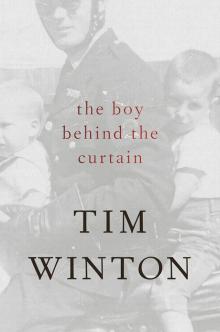 The Boy Behind the Curtain
The Boy Behind the Curtain Scission
Scission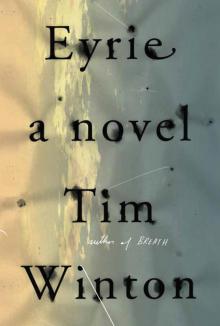 Eyrie
Eyrie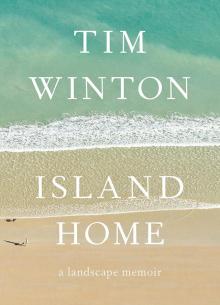 Island Home
Island Home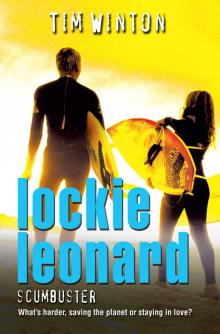 Scumbuster
Scumbuster The Turning
The Turning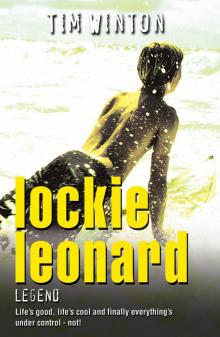 Legend
Legend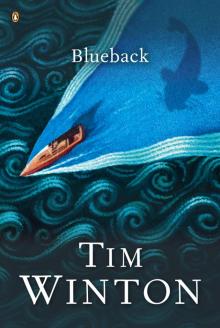 Blueback
Blueback Signs of Life
Signs of Life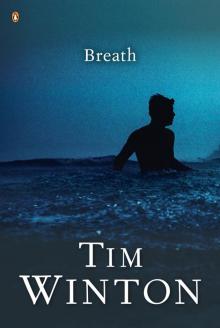 Breath
Breath Land's Edge
Land's Edge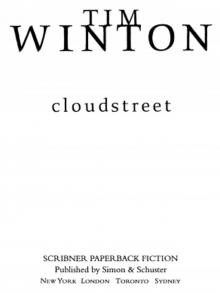 Cloudstreet
Cloudstreet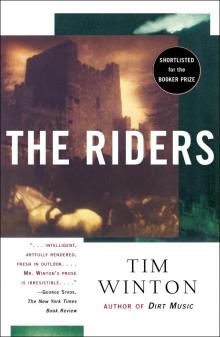 The Riders
The Riders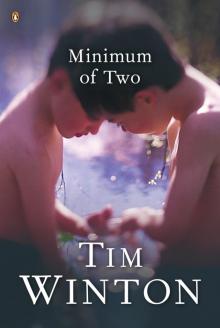 Minimum of Two
Minimum of Two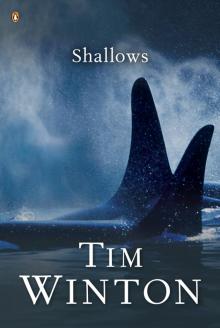 Shallows
Shallows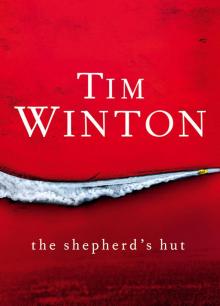 The Shepherd's Hut
The Shepherd's Hut In the Winter Dark
In the Winter Dark